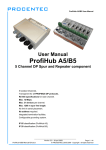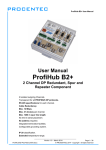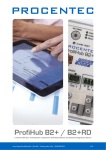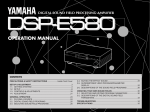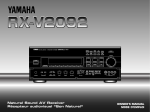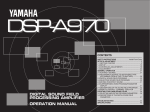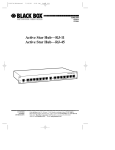Download Black Box Local Mux-6 Specifications
Transcript
MAY 1998 MX873A Miniature Local Mux-12 SS POWER SYNC LO C TEST REM LO INPUT 9V-DC CUSTOMER SUPPORT INFORMATION Order toll-free in the U.S.: Call 877-877-BBOX (outside U.S. call 724-746-5500) FREE technical support 24 hours a day, 7 days a week: Call 724-746-5500 or fax 724-746-0746 Mailing address: Black Box Corporation, 1000 Park Drive, Lawrence, PA 15055-1018 Web site: www.blackbox.com • E-mail: [email protected] MINIATURE LOCAL MUX-12 FEDERAL COMMUNICATIONS COMMISSION AND INDUSTRY CANADA RADIO FREQUENCY INTERFERENCE STATEMENTS This equipment generates, uses, and can radiate radio-frequency energy, and if not installed and used properly, that is, in strict accordance with the manufacturer’s instructions, may cause interference to radio communication. It has been tested and found to comply with the limits for a Class A computing device in accordance with the specifications in Subpart B of Part 15 of FCC rules, which are designed to provide reasonable protection against such interference when the equipment is operated in a commercial environment. Operation of this equipment in a residential area is likely to cause interference, in which case the user at his own expense will be required to take whatever measures may be necessary to correct the interference. Changes or modifications not expressly approved by the party responsible for compliance could void the user’s authority to operate the equipment. This digital apparatus does not exceed the Class A limits for radio noise emission from digital apparatus set out in the Radio Interference Regulation of Industry Canada. Le présent appareil numérique n’émet pas de bruits radioélectriques dépassant les limites applicables aux appareils numériques de classe A prescrites dans le Règlement sur le brouillage radioélectrique publié par Industrie Canada. 1 MINIATURE LOCAL MUX-12 NORMAS OFICIALES MEXICANAS (NOM) ELECTRICAL SAFETY STATEMENT INSTRUCCIONES DE SEGURIDAD 1. Todas las instrucciones de seguridad y operación deberán ser leídas antes de que el aparato eléctrico sea operado. 2. Las instrucciones de seguridad y operación deberán ser guardadas para referencia futura. 3. Todas las advertencias en el aparato eléctrico y en sus instrucciones de operación deben ser respetadas. 4. Todas las instrucciones de operación y uso deben ser seguidas. 5. El aparato eléctrico no deberá ser usado cerca del agua—por ejemplo, cerca de la tina de baño, lavabo, sótano mojado o cerca de una alberca, etc.. 6. El aparato eléctrico debe ser usado únicamente con carritos o pedestales que sean recomendados por el fabricante. 7. El aparato eléctrico debe ser montado a la pared o al techo sólo como sea recomendado por el fabricante. 8. Servicio—El usuario no debe intentar dar servicio al equipo eléctrico más allá a lo descrito en las instrucciones de operación. Todo otro servicio deberá ser referido a personal de servicio calificado. 9. El aparato eléctrico debe ser situado de tal manera que su posición no interfiera su uso. La colocación del aparato eléctrico sobre una cama, sofá, alfombra o superficie similar puede bloquea la ventilación, no se debe colocar en libreros o gabinetes que impidan el flujo de aire por los orificios de ventilación. 2 MINIATURE LOCAL MUX-12 10. El equipo eléctrico deber ser situado fuera del alcance de fuentes de calor como radiadores, registros de calor, estufas u otros aparatos (incluyendo amplificadores) que producen calor. 11. El aparato eléctrico deberá ser connectado a una fuente de poder sólo del tipo descrito en el instructivo de operación, o como se indique en el aparato. 12. Precaución debe ser tomada de tal manera que la tierra fisica y la polarización del equipo no sea eliminada. 13. Los cables de la fuente de poder deben ser guiados de tal manera que no sean pisados ni pellizcados por objetos colocados sobre o contra ellos, poniendo particular atención a los contactos y receptáculos donde salen del aparato. 14. El equipo eléctrico debe ser limpiado únicamente de acuerdo a las recomendaciones del fabricante. 15. En caso de existir, una antena externa deberá ser localizada lejos de las lineas de energia. 16. El cable de corriente deberá ser desconectado del cuando el equipo no sea usado por un largo periodo de tiempo. 17. Cuidado debe ser tomado de tal manera que objectos liquidos no sean derramados sobre la cubierta u orificios de ventilación. 18. Servicio por personal calificado deberá ser provisto cuando: A: El cable de poder o el contacto ha sido dañado; u B: Objectos han caído o líquido ha sido derramado dentro del aparato; o C: El aparato ha sido expuesto a la lluvia; o D: El aparato parece no operar normalmente o muestra un cambio en su desempeño; o E: El aparato ha sido tirado o su cubierta ha sido dañada. 3 MINIATURE LOCAL MUX-12 TRADEMARKS USED IN THIS MANUAL Any trademarks mentioned in this manual are acknowledged to be the property of the trademark owners. 4 MINIATURE LOCAL MUX-12 Contents Chapter Page 1. Specifications. . . . . . . . . . . . . . . . . . . . . . . . . . . . . . . 7 1.1 Sub Channels. . . . . . . . . . . . . . . . . . . . . . . . . . . . 7 1.2 Main Channel . . . . . . . . . . . . . . . . . . . . . . . . . . . 8 1.3 General . . . . . . . . . . . . . . . . . . . . . . . . . . . . . . . . 8 2. Introduction . . . . . . . . . . . . . . . . . . . . . . . . . . . . . . . 10 2.1 General . . . . . . . . . . . . . . . . . . . . . . . . . . . . . . . . 10 2.2 Functional Description . . . . . . . . . . . . . . . . . . . . 10 2.3 Applications . . . . . . . . . . . . . . . . . . . . . . . . . . . . . 11 3. Installation. . . . . . . . . . . . . . . . . . . . . . . . . . . . . . . . . 14 3.1 General . . . . . . . . . . . . . . . . . . . . . . . . . . . . . . . . 14 3.2 Physical Installation. . . . . . . . . . . . . . . . . . . . . . . 14 3.3 Site Preparation. . . . . . . . . . . . . . . . . . . . . . . . . . 14 3.4 Setup . . . . . . . . . . . . . . . . . . . . . . . . . . . . . . . . . . 14 3.5 Electrical Installation . . . . . . . . . . . . . . . . . . . . . 16 5 MINIATURE LOCAL MUX-12 Contents (continued) Chapter Page 4. Operation . . . . . . . . . . . . . . . . . . . . . . . . . . . . . . . . . 20 4.1 General . . . . . . . . . . . . . . . . . . . . . . . . . . . . . . . . 20 4.2 Indicators . . . . . . . . . . . . . . . . . . . . . . . . . . . . . . . 20 4.3 Operating Procedure . . . . . . . . . . . . . . . . . . . . . 20 4.3.1 Powering On the Unit . . . . . . . . . . . . . . . 20 4.3.2 Operation . . . . . . . . . . . . . . . . . . . . . . . . . 21 4.3.3 Powering Off the Unit . . . . . . . . . . . . . . . 21 4.4 Operational Field Strapping Changes. . . . . . . . 21 5. Diagnostics. . . . . . . . . . . . . . . . . . . . . . . . . . . . . . . . . 22 5.1 Remote Loopback . . . . . . . . . . . . . . . . . . . . . . . . 22 5.2 Fault Isolation and Troubleshooting. . . . . . . . . 23 Appendix: Bracket Assembly . . . . . . . . . . . . . . . . . . . . 24 6 MINIATURE LOCAL MUX-12 1. Specifications 1.1 Sub-Channels Transmission Format—Asynchronous Mode of Operation—Full duplex Data Rate—Up to 19.2 kbps Interface—EIA RS-232/CCITT V.24 Connectors—(12) RJ-45 female Number of Sub-channels—12 Distortion—See Table 1-1. User may select six subchannel operation for reduced distortion by internal strapping. Table 1-1. Performance at various bit rates. Sub-channel Distortion (%) Distortion (%) bit rate (Kbps) 6-channel mode 12-channel mode 19.2 9.6 4.8 2.4 1.2 12.5 6.3 3.2 1.6 0.8 25 12.5 6.3 3.2 1.6 7 MINIATURE LOCAL MUX-12 1.2 Main Channel Transmission Line—4-wire unconditioned telephone lines (two twisted pairs) Operating Range—1 mile (1.6 km) maximum on 22 AWG cable (actual distance may vary, depending on the cable you use) Data Rate—1.2288 Mbps Output Format—Balanced bipolar transformer isolated Output Level—6 V ptp (on 100 ohms) Input Resistance—110 ohms Connectors—(1) RJ-45 female 1.3 General Indicators—Power, Local Sync Loss, Remote Sync Loss Table 1-2. Indicators. Indicator Function Power Local Sync Loss Remote Sync Loss Test ON when unit is powered. ON when synchronization is lost at the local Mux. ON when synchronization is lost at the remote Mux. ON when remote Mux is performing a loopback. 8 MINIATURE LOCAL MUX-12 Temperature—32 to 122°F (0 to 50°C) Humidity—Up to 95%, noncondensing Power Consumption—Input: 110 VAC, Output: 200 mA @ 9 VDC Size—1.3"H x 4.5"W x 7.4"D (3.4 x 11.4 x 18.7 cm) Weight—10.7 oz. (300 g) 9 MINIATURE LOCAL MUX-12 2. Introduction 2.1 General The Miniature Local Mux-12 is a time-division multiplexor that enables up to 12 terminals to be multiplexed onto a single cable, in point-to-point applications. The Mux-12 contains a built-in line driver that extends the high-speed multiplexed data over twisted pairs. 2.2 Functional Description The Mux-12 has 12 sub-channels that are connected by RJ-45 connectors accessible from the top panel. The unit can be strapped for 6 or 12 sub-channels according to the desired application. Multiplexing is implemented using an over-sampling technique that enables each one of the 12 channels to be sampled at a rate of 78.6 kbps. This technique results in oversampling distortions, with a magnitude proportional to the bit rate of the sub-channel. Table 2-1 summarizes the performance at various speeds and modes of operation. 10 MINIATURE LOCAL MUX-12 NOTE Whenever possible (when the number of channels is 6 or less), we advise operating the Mux in the 6-channel mode, which results in less distortion. Table 2-1. Performance at various bit rates. Sub-channel Distortion (%) Distortion (%) bit rate (kbps) 6-channel mode 12-channel mode 19.2 9.6 4.8 2.4 1.2 12.5 6.3 3.2 1.6 0.8 25 12.5 6.3 3.2 1.6 2.3 Applications The primary application of the Mux-12 is for point-topoint configurations at distances of up to 0.6 miles (1 km). A typical application is demonstrated in Figure 2-1, where a cluster of terminals is connected to a host computer through a single link. 11 MINIATURE LOCAL MUX-12 Miniature Local Mux-12 Host Terminals Figure 2-1. Typical point-to-point installation. For installations involving clusters of terminals distributed in several locations, the Mux-12 units may be installed in a ring-type configuration as shown in Figure 2-2. At each site, the unconnected channels must be bypassed by shorting TX pin to RX pin of the relevant sub-channel’s connector. Be aware that oversampling distortions are accumulative, so this application limits the bit rate of the sub-channels. 12 MINIATURE LOCAL MUX-12 Host Miniature Local Mux-12 Miniature Local Mux-12 Terminals Miniature Local Mux-12 Terminals Figure 2-2. Typical ring installation. 13 MINIATURE LOCAL MUX-12 3. Installation 3.1 General This chapter provides the information you need to implement the mechanical and electrical installation of the Mux-12. After installation is complete, refer to Chapter 4 for operating information and system checkout to assure normal operation. 3.2 Physical Installation The Mux-12 comes completely assembled and is designed to be secured to a bench or wall using screws. 3.3 Site Preparation The Mux-12 is installed within 5 ft. (1.5 m) of an AC outlet enabling connection of the power-supply adapter. 3.4 Setup Installation of the Mux is straightforward. First review Table 2-1; the factory setting is for 12 sub-channels. If this suits your requirements, you can skip steps 1 through 3 below. 14 MINIATURE LOCAL MUX-12 1. Open the top half of the plastic case by squeezing the marked places on the sides. 2. Strap the multiplexor for 6 or 12 sub-channels according to the printed circuit board. 3. To close the unit, simply press the two halves of the case together. 4. Install the Mux within 5 ft. (1.5 m) of an AC outlet. The unit can be wall-mounted by four screws through the mounting brackets located at both sides of the unit. 5. Connect 9 to 12 VDC from a wall-mounted AC adapter into the DC jack of the Mux. The “POWER” LED should be lit. Other LEDs may be lit as well. 6. Connect the sub-channels to your equipment. Pin assignment of the RJ-45 sub-channel connector is given in Table 3-1. For a description of the RJ-45 connector, see Figure 3-2. 7. Connect the main channel of the Mux to the wiring that connects it to the remote Mux. Pin assignment of the RJ-45 main channel connector is given in Table 3-2. Note that the Transmit Pair 15 MINIATURE LOCAL MUX-12 of one unit should be connected to the Receive Pair of the other unit, and vice versa. All LEDs should be “OFF” (with the exception of “POWER”) indicating normal operation. 3.5 Electrical Installation 3.5.1 AC POWER The Mux is powered by an external power supply of 9 to 12 VDC capable of supplying at least 300 mA. A miniature wall-mount power supply can be used to provide the required power. The power supply is connected to the Mux by a cable ending with a miniature 2 mm DC plug (tip positive, sleeve ground). 3.5.2 SUB-CHANNELS Twelve RJ-45 8-pin jacks located on the top panel enable end users to be connected to the unit. Detailed information about the signals present at this jack and pin configuration are given in Table 3-2 and Figure 3-2. 16 MINIATURE LOCAL MUX-12 Table 3-1. Sub-channel connector pin assignments. CCITT V.24 EIA RS-232C Pin No. Signal Name Description 102 103 AB BA 7 5 Signal Ground Transmit Data 104 BB 3 Receive Data 105 106 107 CA CB CC 2 8 6 Request to Send Clear to Send Data Set Ready 109 CF 4 Receive Line Signal Detector (Carrier Detect) — — 1 +V output Common signal. Serial data from DTE into the Mux. Serial data output from the Mux Connected to CTS. Connected to RTS. A positive level from the Mux except when either a sync loss occurs or remote loopback is performed. A positive level from the Mux except when either a sync loss occurs or remote loopback is performed. A positive unregulated voltage to power external equipment (up to 120 mA total). Table 3-2. Main channel’s connector pin assignment. Pin No. Signal Name Description 1 2 7 8 RX-A RX-B TX-A TX-B Receive Pair Transmit Pair 17 MINIATURE LOCAL MUX-12 1 8 Figure 3-1. RJ-45 socket (female) external view. 18 MINIATURE LOCAL MUX-12 1 8 Figure 3-2. RJ-45 plug (male) clip at rear. 19 MINIATURE LOCAL MUX-12 4. Operation 4.1 General This chapter contains a list of the Mux-12’s indicators, their functions and operating procedures. Installation procedures given in Chapter 3 must be completed and checked before attempting to operate the Mux. 4.2 Indicators Four indicators are located on the Mux’s top panel (see Figure 4-1). Their functions are described in Table 4-1. Table 4-1. Indicator functions. Indicator Function Power Test Local Sync Loss Remote Sync Loss ON when unit is powered ON when remote Mux is performing a loopback ON when synchronization is lost at the local unit ON when synchronization is lost at the remote unit 4.3 Operating Procedure 4.3.1 POWERING ON THE UNIT To power on the Mux, connect the power cable to the Mux’s jack, then plug the power supply unit into the mains. The POWER indicator should light. If the link to 20 MINIATURE LOCAL MUX-12 the remote Mux is still not operational, the SYNC LOSS indicators should be lit. 4.3.2 OPERATION The Mux operates entirely unattended except when occasional monitoring of LED indicators is required. 4.3.3 POWERING OFF THE UNIT To power off the Mux, simply remove the power adapter from the AC source. 4.4 Operational Field Strapping Changes If you need to reconfigure the Mux for 6- or 12-channel mode, simply follow the appropriate setup procedure given in Section 3.2. 21 MINIATURE LOCAL MUX-12 5. Diagnostics 5.1 Remote Loopback Remote loopback can be performed by the Mux-12 when operated in conjunction with the single-port Miniature Local Mux. The test is performed by pressing the RLB button switch located on the front panel of the single-port Mux, which results in looping data back from the remote Mux-12’s receiver to the transmitter. The test checks the single-port Mux’s digital circuitry as well as both local and remote analog interfaces, the mainchannel link, and the Mux-12’s digital receiver section. NOTE When either local or remote loopback test is performed by the single-port Mux, the TEST LED should be lit while all other LEDs should be off at the remote Mux-12. At the same time the Received Data signals (Circuit 104) at the Mux-12’s sub-channels are set to MARK (negative voltage) condition. 5.2 Fault Isolation and Troubleshooting The symptoms and corresponding procedures listed in Table 5-1 enable you to identify, isolate, and correct faults. 22 MINIATURE LOCAL MUX-12 WARNING These service instructions are for use by qualified personnel only. To avoid shock, do not perform any servicing other than that contained in the operating instructions unless you are qualified to do so. Table 5-1. Fault isolation and troubleshooting. Symptom Action All front-panel indicators are off a) Check that power is supplied to the unit. b) Replace unit. The fault is probably in the unit’s powersupply circuits. Local SYNC LOSS and/or a) Check the main channel’s connection at both sites. Verify REMOTE SYNC LOSS that these connections are in accordance with the procedure is ON described in Section 3.4.7 and 3.5.3. b) Replace both units: one at a time. If the problem still exists, the main channel link between the units is probably defective and should be checked. 23 MINIATURE LOCAL MUX-12 Appendix: Bracket Assembly 1. The Mux is provided with two mounting brackets, which mate with a pair of slots on each end of the Mux case. 2. Each bracket has a pair of flanges that slide into the Mux case slots. Mounting Flanges Figure A-1. Top view of mounting bracket. 3. To attach the brackets, hold the Mux case facing upward. Slide the bracket flanges firmly into their slots on the Mux case. When slid all the way, the brackets snap into a locked position. 24 MINIATURE LOCAL MUX-12 Figure A-2. Before mounting the brackets. Figure A-3. After mounting the brackets. 25 © Copyright 1998. Black Box Corporation. All rights reserved. 1000 Park Drive • Lawrence, PA 15055-1018 • 724-746-5500 • Fax 724-746-0746



























